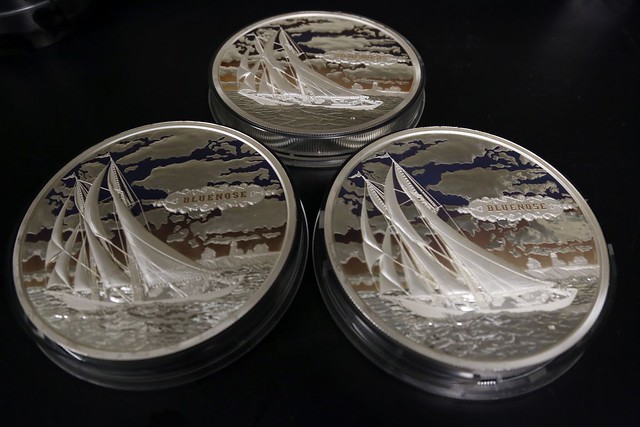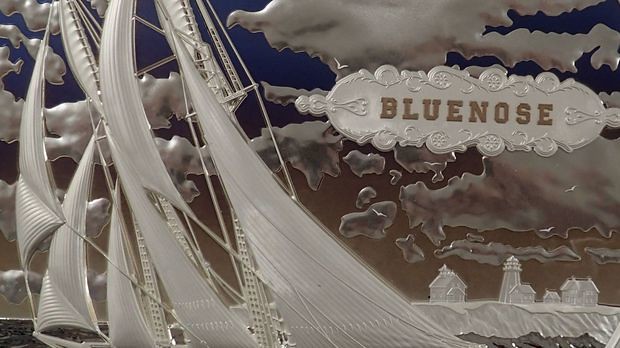
PREV ARTICLE
NEXT ARTICLE
FULL ISSUE
PREV FULL ISSUE
CANADIAN MINT'S LASER COLORING TECHNOLOGYCanada's Globe and Mail published a great article June 30, 2019 about the cool laser technology the Royal Canadian Mint is using. Here's an excerpt. Check out the complete article online. -Editor
 Using powerful infrared light, researchers have found a way to tint metal without dyes or pigments – with scientific implications far beyond coin-collecting. The Bluenose is pictured on the starboard tack, elegantly riding a brilliant froth of waves as it manoeuvres out to sea. But what really catches the eye is not the famous schooner – it's the sky behind it. Instead of a pale metallic sheen, that portion of the collector's coin is coloured like a vivid sunset that transitions from golden pink near the horizon to a deep blue by the time it reaches the top of the ship's main mast. Amazingly, the effect was achieved without the use of dyes, inks or pigments. "It's just pure silver," Iain Brooks, senior manager of applied research at the Royal Canadian Mint in Ottawa said as he cradled the hefty, five-kilogram coin with two hands. The coin is both an art piece and a test of a surprising new technique dubbed "plasmonic colouring" that was developed by the Mint together with researchers at the University of Ottawa. It was created with the help of a picosecond laser, which can blast its target with precise, high-energy pulses of infrared light that last only one trillionth of a second. Researchers have discovered that by applying the pulses in just the right way, they can microscopically tailor a coin's metallic surface so that it transmits only certain wavelengths of light while absorbing others. In essence, instead of colouring a coin, the technique allows a coin to colour the light it reflects. The made-in-Canada innovation could have a range of future applications from anti-counterfeiting strategies to medical sensors. But what has numismatists (collectors of coins, currency and medals) talking is the use of the technique as a tool for creating colourful coins without additives or coatings that would reduce the purity of the metal. "It's groundbreaking," said Henry Nienhuis, president of the Royal Canadian Numismatic Association. "This pushes the envelope in the minting process." The reaction is good news for the Mint, which is looking to generate revenue by issuing special coins that wow collectors with something no one has achieved before. "We wanted to create interesting optical effects on coins," Dr. Brooks said. "And so we began experimenting." 
By 2017, the scientists on the project were asked to submit ideas for a large-size collectors' coin that would showcase the technique. While watching the setting sun from his family's cottage on a lake near Smiths Falls, Ont., Dr. Guay suddenly had an idea. The smooth gradation in hue from red to blue in a sunset sky would be ideal for showing what the technique could do that was difficult with more conventional methods of colouring metal. The idea evolved into a design with the Bluenose in the foreground. Last year, a few samples were produced.  Because each coin needs to be worked individually with the laser – a process that takes about two hours for a piece of that size – it's unlikely that more than 100 of the five-kilogram Bluenose coins will be made. Specialized silver coins of that size are typically valued at more than $10,000. The Mint is tentatively planning to auction off a limited number at a charity event next year that would mark the upcoming centenary of the launch of the Bluenose. While the technique is not being considered for mass circulation coins, Mr. Nienhuis said he hopes it will eventually migrate to smaller collectible coins that can be bought at more modest prices. "That's where I find it more exciting," he said. "I'm looking forward to seeing how [the process] is used in the future." To read the complete article, see:

Wayne Homren, Editor The Numismatic Bibliomania Society is a non-profit organization promoting numismatic literature. See our web site at coinbooks.org. To submit items for publication in The E-Sylum, write to the Editor at this address: whomren@gmail.com To subscribe go to: https://my.binhost.com/lists/listinfo/esylum All Rights Reserved. NBS Home Page Contact the NBS webmaster 
|
